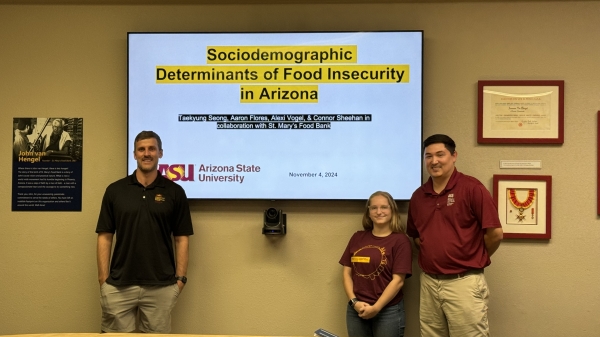ASU, Mexico partner to build next generation of chipmakers, drive semiconductor innovation
From left: Universidad Tecmilenio rector Bruno Zepeda, Ambassador of Mexico to the U.S. Esteban Moctezuma Barragán, ASU President Michael Crow and Universidad Autónoma de Baja California rector Luis Enrique Palafox Maestre photographed with the newly signed addenda to the memorandum of understanding. Photo by Hager Sharp
Thousands of college students in Mexico will soon have the opportunity to enroll in Arizona State University’s new, free online course to learn the fundamentals of microelectronics and nanoelectronics.
Designed by ASU's Ira A. Fulton Schools of Engineering and Global Launch, the new course is part of the university’s binational knowledge partnership with Mexico, which aims to advance North American competitiveness and ensure the global semiconductor supply chain meets demands for digital security and transformation worldwide.
“Every facet of semiconductors, which are fundamental to our economic and national security, will not be controlled by entities outside of the United States, except our closest allies and us working together,” said ASU President Michael Crow. “Their research, their development, their manufacturing, their systems development, their outcomes and the technologies that come from them will be controlled by the U.S. and its partners.”
Key leaders in the effort, including Crow and Esteban Moctezuma Barragán, ambassador of Mexico to the United States, along with distinguished guests from ASU, state governments and academia in Mexico, gathered on Dec. 10 to commemorate the collaboration between ASU and Mexico, and to celebrate a shared vision for the future of the semiconductor industry.
“The current political discussions about North American integration remind us that, while we strive for greater cooperation, there are challenges that require careful navigation,” said Moctezuma in his opening remarks. “Our partnership with ASU serves as a model of how we can work together to address these challenges.”
The partnership aims to develop a highly skilled, readily available workforce, supported by efficient supply chains, modern transportation infrastructure, and world-class higher education systems. These elements will help create a dynamic and innovative business environment.
Many partners expressed their gratitude for being part of such a significant partnership and shared optimism for the future growth and success of the region.
“I commend Arizona State (University) and the Embassy of Mexico in the United States for preparing for the talent development required and the training of professionals in an interconnected and diverse world,” said Mexico’s Secretary of Education Mario Delgado. “We have everything needed to drive a revolution in this technology sector, and in Mexico, we will make the most of it.”
The partnership has already helped 21,000 learners in Mexico, and Crow expects this number to grow to 50,000 soon, with the long-term goal of training hundreds of thousands of workers through the program.
“The advanced chips that are being developed now are functionally differentiated based on the way that they calculate, the speed as they calculate,” Crow said. “I would just recommend that in the new government, in both new governments, that we find a way to facilitate a joint binational research initiative in this space.”
With a focus on long-term economic growth and resilience, ASU continues to transform bold industry ideas into high-impact solutions that benefit learners, communities and the world. ASU’s ongoing initiatives hold great promise for connecting market needs, cutting-edge research, education and commercial application, creating lasting benefits for all.
“And this means that Mexico could become a central technological foundation for all of North America,” Crow said.
More Science and technology

ASU, St. Mary’s Food Bank partner to tackle food insecurity in Arizona
Arizona State University and St. Mary’s Food Bank (SMFB) have joined forces to create an interactive data dashboard that tracks and maps food insecurity rates across Arizona. This innovative tool…

Study reveals genetic insight into desert survival
The deserts of the American Southwest are home to the Mojave and Sonoran desert tortoises, two seemingly similar yet genetically distinct species of turtles. These tortoises, adapted to different…

Study reveals lasting effects of common weed killer on brain health
Environmental exposure to toxins in the air, water or certain chemicals can increase the risk of ill health effects, including to the human brain.The human brain is an incredibly adaptable organ,…